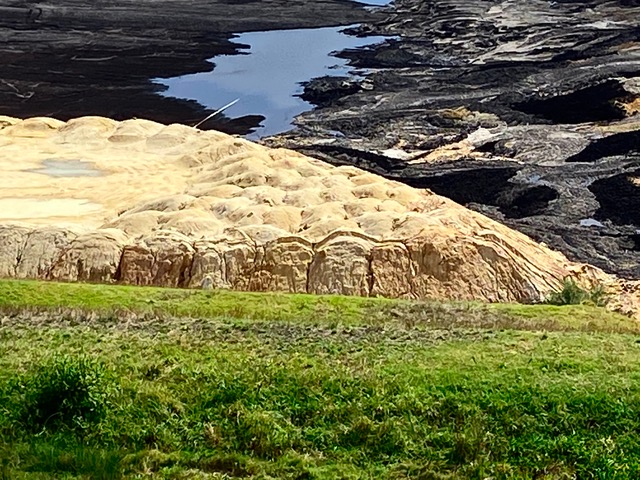This is the fourth and final article in a series of four.
The first article covered the “Geology of the Latrobe Valley” in which we learnt:
- the brown coal resources of the Latrobe Valley are vast and extensive,
- there are lots of coal with very little covering material,
- the coal is very “young”, is physically neither rock nor clay and behaves uniquely,
- the brown coal has significant jointing (zones of weakness),
- the geology at each site is unique with some having underlying aquifers requiring consideration,
- this situation is unique in the world,
- brown coal has a low resistance to water pressure,
- brown coal “weathers” exceptionally well and does not easily erode.
The second article covered the “Impacts from Mining” in which we learnt:
- Digging any hole creates horizontal relaxation which can lead to individual batter destabilisation.
- The predominate “highly dispersive” clays overlying the brown coal deposits can also lead to individual batter destabilisation.
- The local groundwater table is lowered by mining which creates conditions where water ingress into coal batters may precipitate movement.
- Slopes at the bottom of coal and the immediate underlying material properties can have a significant impact on batter stability. The properties of the immediately underlying material can be significantly adversely impacted by water saturation and make a stable batter unstable.
- The need to maintain a balance between aquifer pressures and the weight of overlying materials is fundamentally important to floor and batter stability at Hazelwood and Loy Yang voids. There is no such issue at Yallourn. Aquifer levels will increase over time once pumping ceases.
The third article covered “what is required to create safe, stable and sustainable conditions after mining ceases” in which we learnt:
- For all surfaces above water level the land is to be safely accessible for maintenance and fire prevention works.
- Exposed coal surfaces will need to be covered to prevent coal fire from being initiated.
- Ensure our environment is not adversely impacted by toxicity although there may be some residual matters that maybe difficult to manage into perpetuity at the older sites.
- All of the stability related impacts from mining (article 2) will need to be managed in addition to preventing large rapid changes in water levels within mine voids. The most important of these (due to scale of impact) is the maintenance of sufficient weight to counterbalance aquifer pressures.
- The most significant sustainability issue is access to sufficient volumes of sustainable water even without acknowledging the rights of others to access Latrobe River water in future.

Lower Latrobe River
In this article we will discuss the limitations in solving these complex problems.
At the conclusion of Article 3 we saw how significant the water supply requirements would be to flood all 3 mine voids. So, it was no surprise that in a December 2021 briefing update on some LVRRS study results, the summary was:
- The cost of having dry voids is very expensive (although not equal across the 3 sites), and
- There is insufficient available water in the Latrobe River system to fill all 3 mine voids and there are no other sources of water that are economic at this point.
Currently each of the 3 mine void owners proposes to completely fill their mine void with water.
Placement of some water within the Hazelwood and Loy Yang mine voids is logically the quickest and lowest cost alternative to place the needed weight to counterbalance aquifer pressures however there is considerable analysis, across many aspects, to ensure optimal decisions, on water allocations, are made. Sufficient to justify a second phase of studies under the LVRRS.
In the meantime, Hazelwood is about to conduct an Environmental Effects Statement in its plan to entirely fill their mine void with water from the Latrobe River system and aquifer system.
Great Latrobe Park (GLP) has a view that Hazelwood should conduct an EES but only after the bigger picture on water allocation is undertaken using a publically transparent process that encourages Latrobe Valley public involvement. The reasons for not proceeding with Hazelwood’s EES until the bigger picture water allocations are solved are:
- It advantages first movers, so Hazelwood has access to more water than Yallourn and subsequently Loy Yang, irrespective of the risks that need to be mitigated and the potential needs of others.
- Department of Jobs, Precincts and Regions (DJPR) have stated that the lowest cost stability works need to be undertaken prior to water filling commencing. Unfortunately, the target fill level is a significant determinant in the scope of those works. If target fill levels cannot be achieved then residual works to create stable conditions could require, in the worst case, Princes Freeway diversions at Morwell and/or Traralgon or stream diversions of the Morwell River and/or Latrobe River at Yallourn. These are potentially significant costs.
- Asking Hazelwood to conduct an EES implies the problem belongs solely to Hazelwood alone. In reality the State has a very real interest as the timeframes for filling each of the Mine Voids are likely to be 1 or more decades. The gestation period to realising some of the above-mentioned risks is likely to be similar or greater timeframes at which point the State will be holding very little ‘bond” retention money. This increases the likelihood that owners will hand back the keys rather than pay for the impact.
- There are many competing “needs” for water from the Latrobe River system with groups advocating expansion of irrigation, improvement in water quality from increased flows, etc. How do you balance all of these needs with a limited supply of available water?
The Great Latrobe Park (GLP) strongly suggests a public Inquiry (for transparency). The Inquiry would seek to establish the “$ value” and impacts (environmental and social) of packages of water being made available to all prospective users. Water packages are proposed to be in the 200 – 250 Gl range based on a mine void perspective so as not to be evaluating too many water packages, however this may need to be modified based on the volumes of available water from the Latrobe River system, understanding the likely error range on Latrobe River water projections, what other users package requirements are and special cases such as Hazelwood has proposed for the Hazelwood Ash Retention Area (HARA) within the Mine void in their EES document. Such cases should be signed-off by technical experts assisting the Inquiry chair.
As Power Station demand wains this will create opportunities to provide water for other uses. Those parties seeking water would need to apply for access to water.
This would require the State to identify (which probably has already been done):
- the possible future range of available water flows that can be sustainably harvested from the Latrobe River system, after determining
- the base flows that are not negotiable, e.g. environmental flows, and any other aspect considered vitally important.
In order for “$ valuations” to be largely comparable, despite each site being quite different, the Inquiry chair would require a number of technical experts to assist in ensuring comparability in:
- adoption of parameters (e.g., material strength parameters, use of rainfall/run-off and evaporation data, assumptions, etc), and
- methodologies (assessment methods (including water quality for each increment), risk definition, residual risk definition, assessment of impacts and financial modelling of future costs/revenues compared to current costs/revenues).
As a package of water is applied to a mine void it changes the likelihood and consequence of failure which can be calculated in $’s incorporating road and stream diversions and other on-going costs such as fire protection, dewatering, etc. These sum to give the water package a $ value. The use of water also has environmental and social impacts that need to be considered., including over time.
The $ valuation of a package of water allows comparison of cost avoidance with potential future income (for more productive uses of the water) and allows ranking of the higher cost risks or productive water uses ahead of the lower cost risks or productive water uses. This can then be compared with the likely range of sustainable water harvest.
As our understanding of climate change impacts increases or any substantial change in circumstances arise, this assessment methodology could be revisited and applied with the updated information. This makes it imperative that water allocation is graded as:
- Water provided with certainty,
- Water provided without certainty,
- Water not available.
A target water level range could then be determined for each Mine void (incorporating allocations 1 and 2 above as appropriate) allowing Mine void Owners to proceed with a greater degree of surety on what works are required.
The State, through its Regulators, could then ensure Owners conduct the lowest cost batter stabilisation and long-term fire protection works consistent with achieving a low degree of risk and largely avoiding future works and costs that would otherwise likely be borne by the State.
The reason that all 3 mine owners want to fill their void with water is that it provides the best stability outcome (in most cases) at the least cost.
If the State takes control of water allocation (as it should and normally does) then the allocation of water across the 3 mine voids will likely vary significantly as will the financial impacts to current Owners vary significantly across the 3 sites.
The State needs to have pre-thought how to deal with this potentially “unfair” impact.
There are solutions but they need to be thought through early.

Yallourn Open Cut Mine showing floor of mine. Image courtesy of M. Gaulton.
This article has been prepared by Richard Polmear, a member of Great Latrobe Park and former Mine Engineering Manager and Director Mining at Hazelwood during his 34 years of employment in the industry.
This article was published in the Latrobe Valley Express on 11/05/2022, page 23.
This is the fourth and final article in a series of four.
 BACK
BACK

